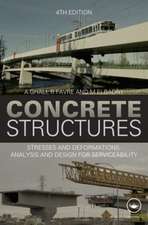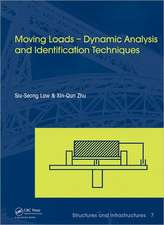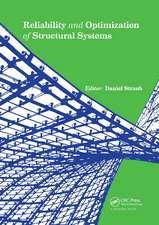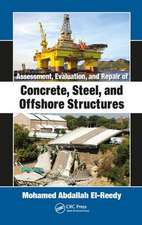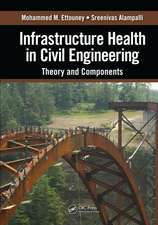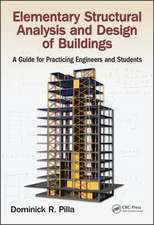Structural Analysis and Design to Prevent Disproportionate Collapse
Autor Feng Fuen Limba Engleză Paperback – 24 ian 2018
Hard Guidance on Preventing Disproportionate Collapse
Disproportionate collapse is a pressing issue in current design practice. Numerous causes are possible - especially forms of extreme loading, such as blast, fire, earthquake, or vehicle collisions. But it is the mechanism and its prevention which are of especial interest and concern.
After the World Trade Center collapse in 2001, interest was sparked, and it is now imperative for a design engineer to have sufficient knowledge on both the analysis and design against disproportionate collapse. Detailed structural design guidance for preventing this has been developed in Europe and the US - such as BS5950 in the UK, and guidance from the Department of Defense and the General Services Administration in the US. However, Structural Analysis and Design to Prevent Disproportionate Collapse is the first systematic text in the market to help design engineers or structural engineering students to properly understand this guidance.
- Covers the design and analysis of a structure to prevent disproportionate collapse
- Provides an understanding of disproportionate collapse problems for different structures under different loads
- Contains detailed knowledge on the design and progressive collapse analysis of complex structures
Incorporates ABAQUS(R), ETABS, SAP2000, and Highlights 3D Modeling Techniques
As progressive collapse analysis is a distinctive and complicated procedure, it normally requires an ability to use a modern commercial finite element package, and Structural Analysis and Design to Prevent Disproportionate Collapse features a detailed introduction to the use of FE programs such as ABAQUS(R) in progressive collapse analysis. In addition, case studies are performed using 3D FE models based on various types of structures such as multi-storey buildings, long-span space structures, and bridges. These models replicate real collapse incidents and prestigious construction projects, such as progressive collapse analysis of the Twin Towers, structural fire analysis of World Trade Center 7, blast analysis of the Murrah Federal Building and progressive collapse analysis of the Millau Viaduct, which help designers to fully understand the failure mechanisms and effective mitigation methods in practice.
Preț: 461.03 lei
Preț vechi: 542.39 lei
-15% Nou
88.23€ • 91.77$ • 72.84£
Carte tipărită la comandă
Livrare economică 14-28 aprilie
Specificații
ISBN-10: 1138490415
Pagini: 202
Ilustrații: 120
Dimensiuni: 156 x 234 x 11 mm
Greutate: 0.45 kg
Ediția:1
Editura: CRC Press
Colecția CRC Press
Cuprins
Notă biografică
Recenzii
—Jianqiao Ye, Lancaster University, UK
"It is of major practical interest and I would definitely recommend it for design engineering offices and lecturers in structural mechanics."
—Philippe Bouillard, Universite Libre de Bruxelles, Belgium
"This book attempts to advance the state of the art by showing how to create computer models of large structures that are then subject to an "event" to see if the subsequent collapse is progressive."
— Roger Davies in TheStructuralEngineer
"An excellent introduction to the progressive collapse of structures that will allow the understanding of the basic aspects of this phenomenon and help improve structural designs. … This is a compact and clearly written book that the reader will find easy to read."
-- Jose M. Adam, in Journal of Performance of Constructed Facilities, ASCE
Descriere
Hard Guidance on Preventing Disproportionate Collapse
Disproportionate collapse is a pressing issue in current design practice. Numerous causes are possible - especially forms of extreme loading, such as blast, fire, earthquake, or vehicle collisions. But it is the mechanism and its prevention which are of especial interest and concern.
After the World Trade Center collapse in 2001, interest was sparked, and it is now imperative for a design engineer to have sufficient knowledge on both the analysis and design against disproportionate collapse. Detailed structural design guidance for preventing this has been developed in Europe and the US - such as BS5950 in the UK, and guidance from the Department of Defense and the General Services Administration in the US. However, Structural Analysis and Design to Prevent Disproportionate Collapse is the first systematic text in the market to help design engineers or structural engineering students to properly understand this guidance.
- Covers the design and analysis of a structure to prevent disproportionate collapse
- Provides an understanding of disproportionate collapse problems for different structures under different loads
- Contains detailed knowledge on the design and progressive collapse analysis of complex structures
Incorporates ABAQUS(R), ETABS, SAP2000, and Highlights 3D Modeling Techniques
As progressive collapse analysis is a distinctive and complicated procedure, it normally requires an ability to use a modern commercial finite element package, and Structural Analysis and Design to Prevent Disproportionate Collapse features a detailed introduction to the use of FE programs such as ABAQUS(R) in progressive collapse analysis. In addition, case studies are performed using 3D FE models based on various types of structures such as multi-storey buildings, long-span space structures, and bridges. These models replicate real collapse incidents and prestigious construction projects, such as progressive collapse analysis of the Twin Towers, structural fire analysis of World Trade Center 7, blast analysis of the Murrah Federal Building and progressive collapse analysis of the Millau Viaduct, which help designers to fully understand the failure mechanisms and effective mitigation methods in practice.






